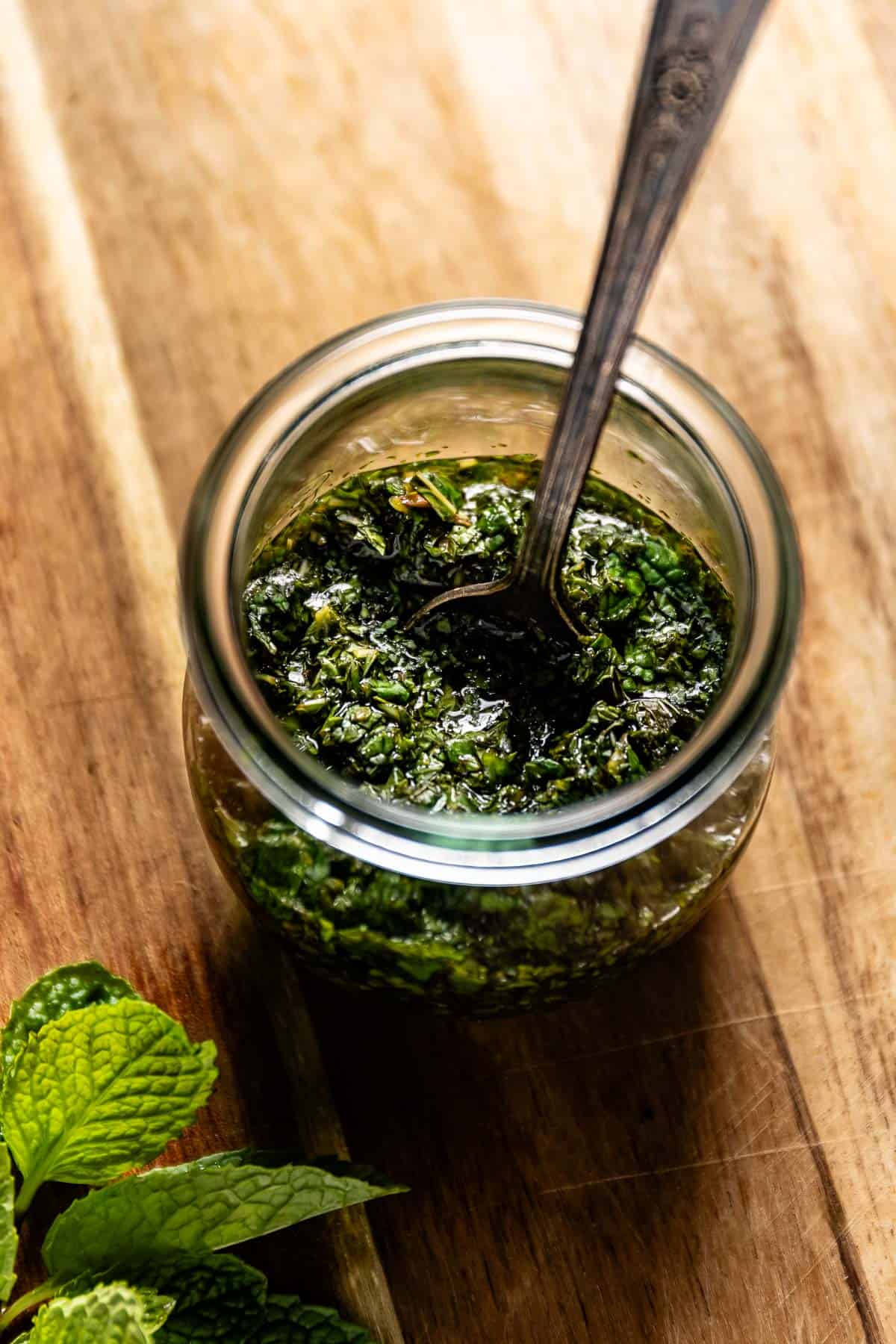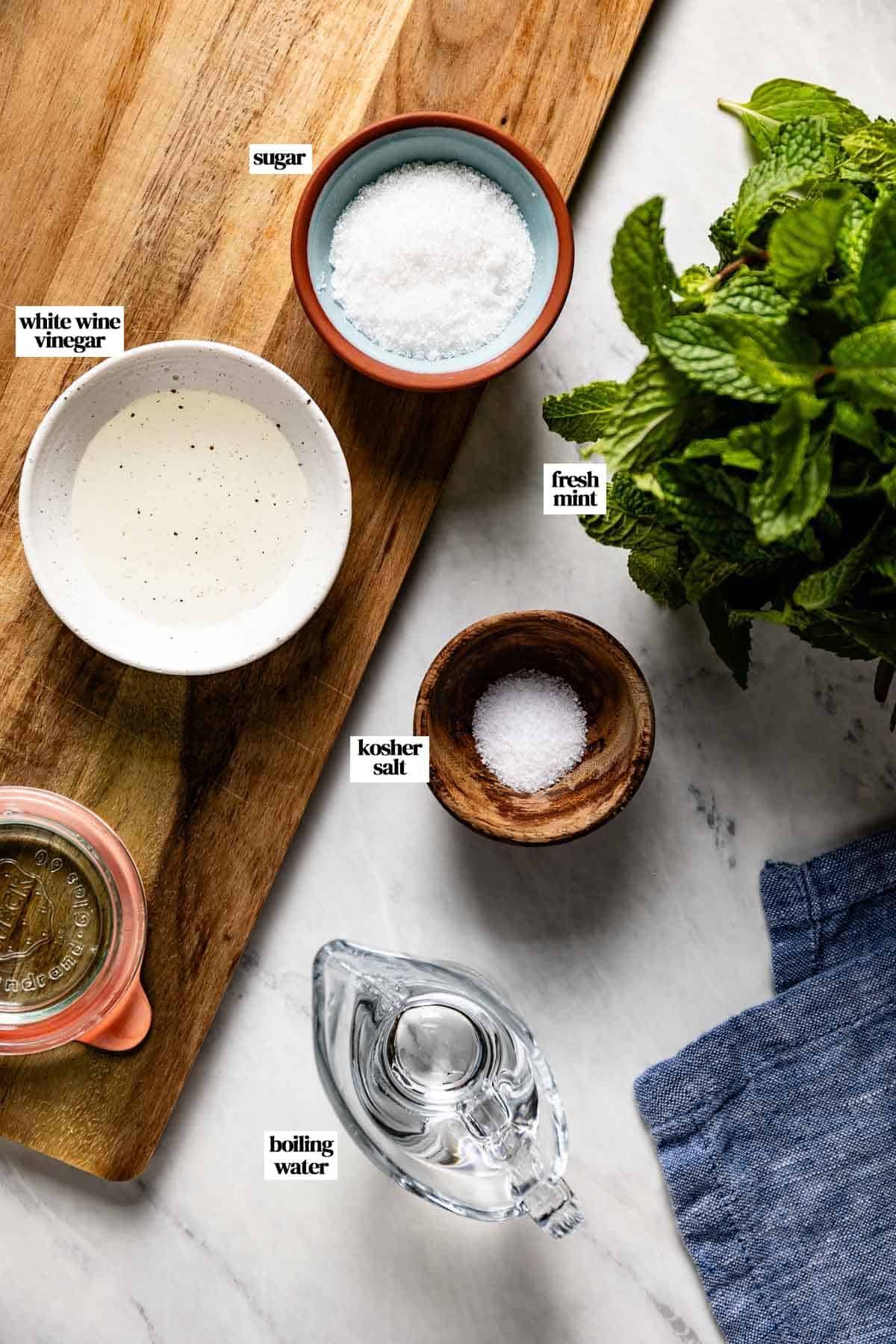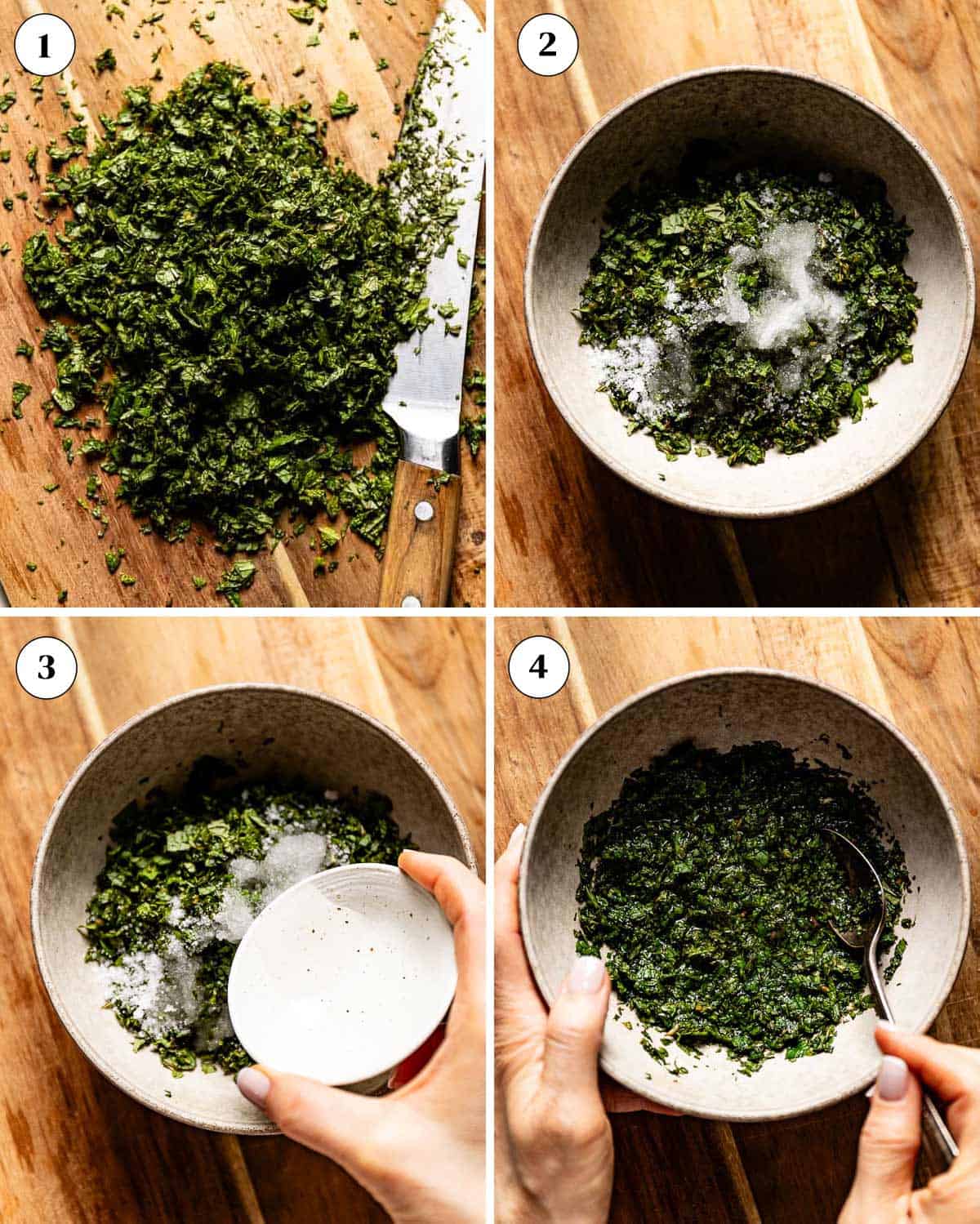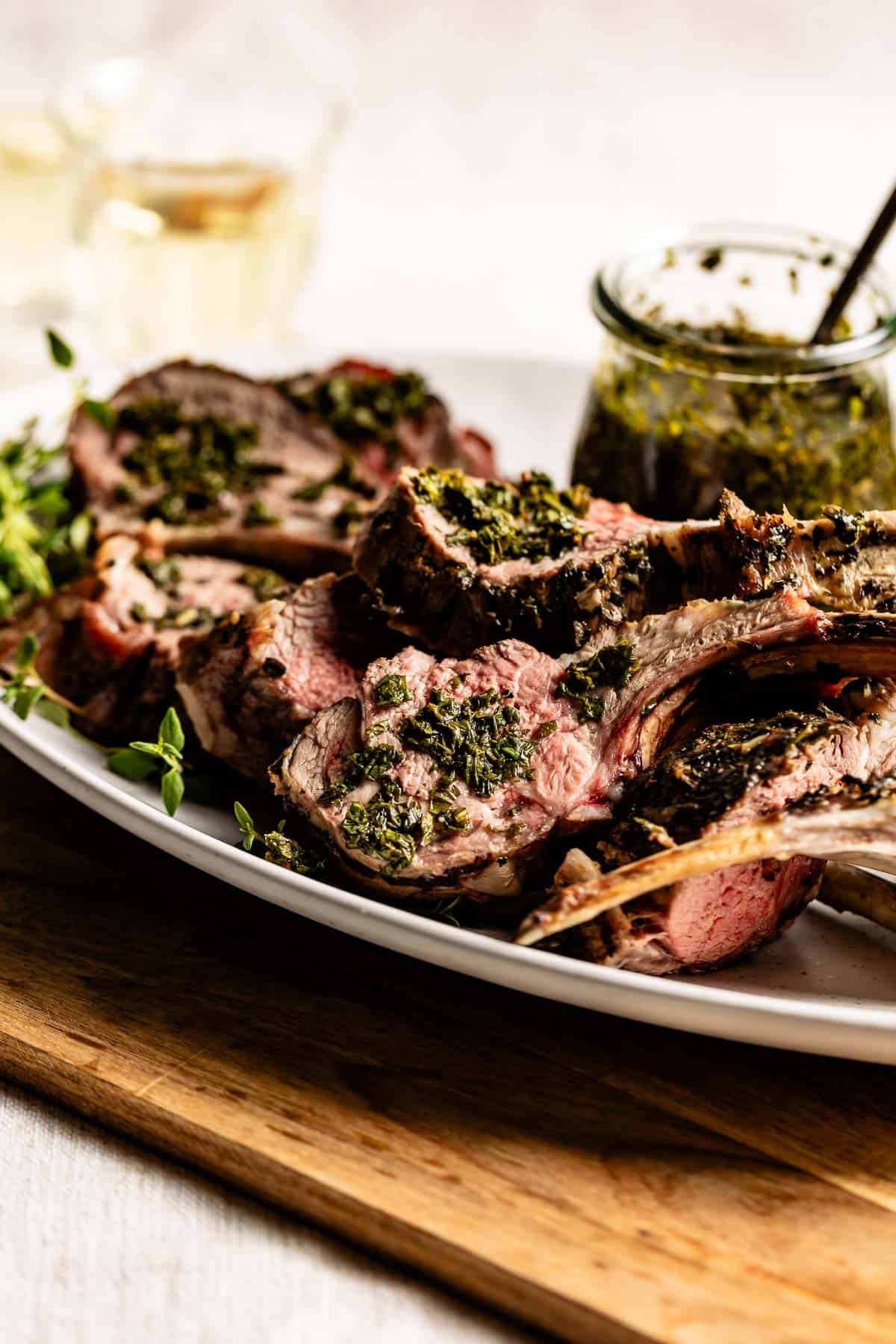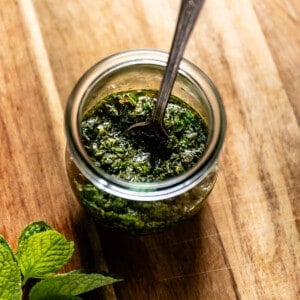Ingredients You’ll Need
One of the best parts about making mint sauce for lamb is how few ingredients you need to get the freshest, most vibrant taste. In fact, you likely already have these simple ingredients in your kitchen, making this recipe a must whether you’re preparing for a special occasion or a quick weeknight dinner.
Fresh mint: I highly suggest using fresh mint leaves or common garden mint for this mint sauce recipe. However, you should be able to find fresh mint at your local grocery store. If you are growing your own mint, then peppermint or spearmint varieties would both work. Sugar: There are many ways to add a touch of sweetness to this iconic condiment. Classic mint sauce recipes for lamb use granulated sugar, but you can also use a cane, coconut, or brown sugar if you’re looking for an alternative, pantry-ready option. Or, if you’d prefer a thicker, more complex sweetness, you can also use honey instead of raw sugar. Kosher salt: A pinch of salt is an excellent addition to this recipe, balancing its sweetness while bringing out its bright mint taste. Vinegar: Adding an acidic component to this lamb mint sauce is critical to enlivening it with savory, tart notes. The original British mint sauce calls for distilled malt vinegar, but you can use white wine vinegar (which I used) or apple cider vinegar if you don’t have any malt vinegar on hand. Boiling water
Storage: After transferring it to an airtight container, you can store it in the refrigerator for 2-3 days. However, remember that the sauce will turn a darker green the longer it sits since the fresh mint loses its bright color during storage. Therefore, even if its taste doesn’t diminish, the sauce may not have the same bright green color as when you first prepared it. Freeze: The best way to freeze this easy mint sauce is in individual portions, ensuring effortless use later on. To do so, I recommend pouring the sauce into an ice cube tray and freezing it until solid. Then, remove the cubes from the tray and place them in a freezer-safe container, such as a Ziplock bag, with as much air removed as possible. Replace the container in the freezer, and you can use each individual serving whenever your menu calls for a serving of bright, cool sauce.
Other Ways to Use Mint Sauce
No one can deny that mint sauce with lamb is one of the most classic flavor combinations, from a succulent roast dinner to a smoky Grilled Rack of Lamb. However, if you have extra sauce or want to try out a new menu, there are dozens of other mouthwatering pairings to try, a few of which I’ve detailed below:
Incorporate it into salad dressings: This mint sauce makes a fantastic base for salad dressing recipes. Simply mix a tablespoon or two of this sauce with a bit of lemon juice and olive oil, and you’ll have a zesty, light dressing perfect for a bed of leafy greens. Add it to yogurt: If you’re like me, you love making a quick, gourmet-level dip you can use for all your favorite snacks. You can quickly transform this recipe into a mint dipping sauce by mixing 1-2 tablespoons into a serving of Greek yogurt and serving it with fresh veggies, pita bread, or as part of a mezze platter. Use it as a marinade for other meats, like chicken or fish: Want to add a brilliantly bright, herby flavor to your meats? Add a bit of this mint sauce to your marinade recipe, and its vibrant notes will beautifully compliment your main dish’s savory, succulent base. Spread over spring vegetables: You can enhance any veggie side by adding a dollop of this minty spread to your plate. In particular, mint sauce makes a great accompaniment for fresh or blanched peas and green beans (especially my Air Fryer Green Beans!), as well as heartier veggies such as roasted potatoes.
Mint stems: Since this recipe requires so much mint (you’ll need 1 large bunch), I encourage you to consider your herb’s freshness when deciding whether to use only the leaves or include the stems. Young, freshly picked stems—like the kind you grow in your home garden—are OK to use in this recipe. However, older stems—the kind you might find at your local grocery store—tend to have a harder, woodsier taste, which might negatively impact the overall flavor of your recipe. No matter which type of minty herb you use, it’s essential that you finely chop it to ensure the leaves fully release and evenly distribute their flavors into the sauce. Food processor: You may have seen that other mint sauce recipes ask you to use a food processor or blender to cut up your mint leaves more thoroughly and blend them with the other ingredients. However, though this is technically an option, you can achieve an ideal fineness by chopping your herbs with a sharp knife. Furthermore, processing your mint may bruise the delicate mint leaves, leaving you with a sauce that has a slightly bitter taste rather than the fresh, vibrant flavor that finely hand-chopped mint leaves can offer. Taste and adjust: The best mint sauce for lamb is one that you adjust according to your personal preference. That’s why I highly encourage you to use this recipe as a base, taste it before serving, and add more seasoning as necessary. I should also note that I find most jarred mint sauces to be too sweet for my taste, so I use a minimal amount of added sugar compared to other recipes. Therefore, if you prefer a sweeter profile, you may add more sweeteners to achieve your ideal balance of sweet and acidic flavors. Let it rest: If you have the time, this homemade mint sauce recipe should rest for 30 minutes before serving. This resting time ensures that the ingredients have time to develop and deepen their flavors. Adjust consistency: Depending on how you plan to use your mint lamb sauce recipe, you might want to adjust its consistency. As written, this recipe will result in a thicker sauce—more like a mint paste—which is ideal for serving with lamb dishes due to their rich meat flavor. However, if you’re looking for a thinner consistency, as you might when making a salad dressing or a saucy drizzle, all you need to do is add more water or vinegar to your mixture. Serve it at room temperature: Though I recommend storing it in the refrigerator, it has the best taste and consistency when served at room temperature. Therefore, if you’ve stored it in the fridge beforehand, I suggest taking it out at least 30 minutes before adding it to your dinner table.

